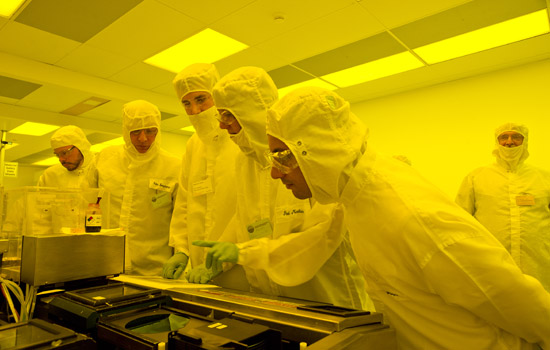RIT offers integrated-circuit training
RIT engineering faculty support Rochester Regional Photonics Cluster program
A. Sue Weisler
Microelectronic engineering faculty presented a weeklong, intensive training course on Integrated Circuit Fabrication, June 17-21. The course is part of a regional workforce development initiative to provide training for individuals in, or intending to begin work, in the optics, imaging or photonics industries.
RIT recently completed a weeklong training in integrated circuit fabrication technology in support of Finger Lakes Economic Development initiatives. The training about semiconductor industry processes was conducted by faculty from the Department of Electrical and Microelectronic Engineering in RIT’s Kate Gleason College of Engineering, and presented to individuals from local, regional and international companies, including India and Singapore.
Twelve students participated in a combination of classroom lectures—about the basic processes used to fabricate chips and the various ways these processes are combined to produce the final integrated circuit—and hands-on work in the Semiconductor and Microsystems Fabrication Lab in the engineering college.
“This is a new area for our business,” says participant Anand Bhushan, employed by Didactica USA, a global company that makes engineering equipment for universities. The short course format was beneficial to him as it provided a broad overview of the processes, the resources necessary in this industry as well as the employee training needed. “It was a chance to see what we can do in this specialized area.”
For the first time, the course is supporting the Rochester Regional Photonics Cluster, a combination of local manufacturing industries and universities based in the region and with expertise in the areas of imaging, optics and photonics—the science of detecting, processing and signaling using light. RIT is one part of a collaborative team with the University of Rochester’s Center for Emerging and Innovative Sciences, High Tech Rochester and the New York State Department of Economic Development providing workforce training and retraining of workers for optics companies. This course aids any company interested in integrating its optical devices on a semiconductor chip.
According to the Western New York STAMP Project, the semiconductor industry is a market approaching $300 billion. States such as New York have invested in the construction of nanotechnology fabrication labs to create integrated circuits used for electronic devices, provided support to associated businesses using the circuits and sponsored workforce training programs for these companies. It is a growing industry with considerable economic and career potential, says Michael Jackson, professor of microelectronic engineering and one of the RIT training facilitators.
“Our training is actually a full-quarter, undergraduate course, Integrated Circuit Process Engineering, because companies involved with photonics preferred it for their employees,” says Jackson. A companion course in optical thin film processing is being developed for other companies interested in lens coatings. “We’re continuing a 30-plus year tradition of providing professional development opportunities for the semiconductor industry.”
Microelectronic engineering faculty also presented a similar model course, Advanced Manufacturing and Nano-Tech Certificate Training, part of the Genesee County Economic Development Center, in 2011.














